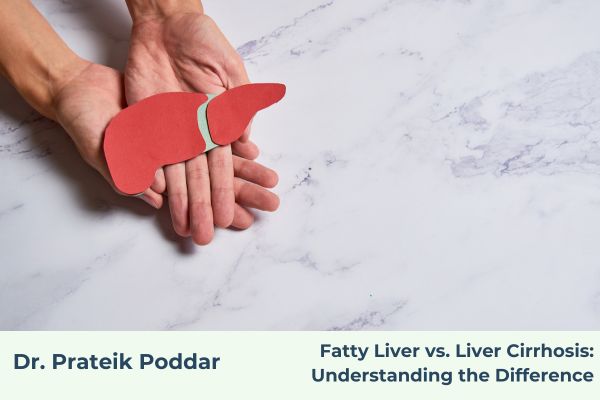Fatty Liver vs. Liver Cirrhosis: Understanding the Difference
Introduction
The liver is a vital organ responsible for metabolism, detoxification, and digestion. However, poor lifestyle choices, alcohol consumption, and metabolic disorders can lead to liver diseases like fatty liver and cirrhosis. Although these conditions are related, they have different outcomes. Understanding their differences can help in early diagnosis and better management.
Dr. Prateik Poddar, a leading liver specialist, provides insights into these two conditions, their causes, and the best treatment approaches.
What is Fatty Liver Disease?
Fatty liver disease occurs when excess fat builds up in the liver, impairing its function. It is classified into two types:
- Non-Alcoholic Fatty Liver Disease (NAFLD) – Caused by obesity, diabetes, high cholesterol, or an unhealthy diet.
- Alcoholic Fatty Liver Disease (AFLD) – Caused by excessive alcohol consumption, leading to liver inflammation.
Symptoms of Fatty Liver:
- Mild abdominal discomfort
- Fatigue and weakness
- Elevated liver enzymes in blood tests
- No noticeable symptoms in the early stages
Treatment for Fatty Liver:
- Healthy diet rich in fruits, vegetables, and lean proteins
- Regular exercise to maintain a healthy weight
- Avoiding alcohol and smoking
- Managing diabetes, cholesterol, and hypertension
Fatty liver is reversible if detected early and managed properly.
What is Liver Cirrhosis?
Cirrhosis is a late-stage, irreversible liver disease where healthy tissue is replaced with scar tissue (fibrosis), affecting liver function. It develops due to prolonged liver damage caused by fatty liver, alcohol abuse, viral hepatitis, or autoimmune diseases.
Symptoms of Cirrhosis:
- Jaundice (yellowing of the skin and eyes)
- Swelling in legs and abdomen (ascites)
- Easy bruising and bleeding
- Mental confusion (hepatic encephalopathy)
- Fatigue, weight loss, and appetite loss
Treatment for Cirrhosis:
Since cirrhosis is irreversible, treatment focuses on managing symptoms and preventing further liver damage:
- Medications to control symptoms like swelling and infections
- Lifestyle changes (healthy diet, quitting alcohol, managing weight)
- Liver transplant in severe cases where the liver loses function
Key Differences Between Fatty Liver and Cirrhosis
| Feature | Fatty Liver | Liver Cirrhosis |
| Cause | Fat accumulation due to obesity, alcohol, or metabolic conditions | Long-term liver damage from untreated fatty liver, alcohol, or hepatitis |
| Reversibility | Yes, with lifestyle changes | No, but progression can be slowed |
| Symptoms | Often asymptomatic, mild discomfort | Severe symptoms like jaundice, swelling, confusion |
| Liver Damage | No permanent scarring | Severe scarring (fibrosis) |
| Treatment | Diet, exercise, alcohol avoidance | Symptom management, possible liver transplant |
How to Protect Your Liver?
Dr. Prateik Poddar recommends the following steps to maintain liver health and prevent serious complications:
Eat a balanced diet rich in fiber, healthy fats, and lean proteins
Exercise regularly to maintain a healthy weight
Limit alcohol intake or avoid it altogether
Stay hydrated and avoid sugary beverages
Get regular liver check-ups to monitor liver function
Conclusion
Fatty liver and cirrhosis are both serious liver conditions, but early detection and lifestyle changes can prevent fatty liver from progressing to cirrhosis. If you have risk factors like obesity, diabetes, or high cholesterol, it is important to take proactive steps to improve your liver health.
If you are experiencing liver-related symptoms or need expert advice, consult Dr. Prateik Poddar today for personalized guidance and treatment options.

